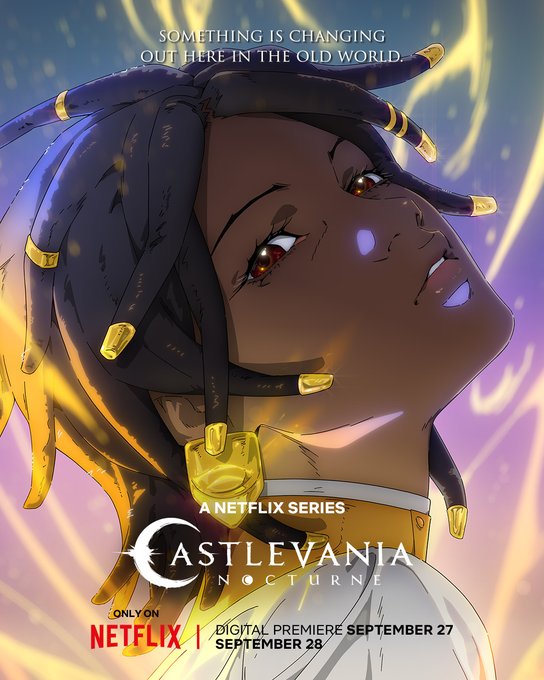Netflix’s Castlevania sequel series, Nocturne, is a chock full of a varied and captivating cast, a plot that has you rooting for unexpected characters, and fight scenes that have your knuckles turning white. Yet, it still falls two steps behind the Netflix Original prequel, Castlevania.
Nocturne is based on the games Rondo of Blood, released in 1993 and its sequel, Symphony of the Night, 1997. Both games and the animated series follows magical Richter Belmont, of the vampire-hunting clan, the Belmonts.
Nocturne takes place three centuries after the events of the prequel series, which follows the trio of Trevor Belmont, Richter’s ancestor, Alucard Tepes, Count Dracula’s son and Sypha Belnades, a power speaker magician.
Richter, on his way to France, watches his mother’s murder, as many fantasy protagonists do. Her murderer, an old vampire named Olrox, promises one day to kill him as well.
In France, nine years later, Richter is raised by Tera and enjoys a sibling relationship with her daughter, Maria. Maria and Tera are speakers, a nomadic group of magicians. Richter though, allegedly lost his magic after his mother’s murder. In fighting a group of night creatures, Richter and his adoptive family are happened upon by Annette and Edouard, who are also vampire-killing hunters.
This is where the story’s journey starts and what a start it is. Not for Richter, but for Olrox.
Olrox is a personal favourite. With many antagonistic characters, the design generally does not stray from the black and white, and occasional red, palette. Olrox dresses in dapper purples and has bright green eyes like a lizard’s. His skin is a dark brown and his hair, long and black.
His arc in Nocturne is also more comparable to an anti-hero than a true antagonist’s. He seems to be the only vampire not under the spell of our main antagonist.
Richter, though, falls a little flat in the face of his predecessor, Trevor. Trevor is an irreverent and often funny personality. He gives off a “could not care less” vibe but he does care very deeply, making him a very charismatic character.
Though, being voiced by Richard Armitage helps his likability as well.
The writing for Richter leaves a reasonable amount to be desired, especially for a first season. Comparing him to his predecessor would not be fair but Richter is not as charismatic or as interesting to watch in a fight as Trevor.
What he lacks in personality, Richter makes up for in prettiness.
Nocturne sees the vampires finding religion in their one true Messiah, the Devourer of Light, who they believe is Erzsebet Báthory, an ancient vampire who regards herself as the reincarnated Egyptian warrior goddess, Sekhmet.
If you’re a history aficionado, you’ll recognize that the name of our primary villain comes from the Hungarian Countess Elizabeth Báthory, who allegedly murdered hundreds of young women in the 16th and 17th century.
Erzesebet falls on the side of Fire lord Ozai in the first season of Avatar: The Last Airbender; an untouchable villain that we know very little about.
What is truly fascinating in both series’ is the use of religion and the Christian Church as almost a secondary villain. The original Castlevania series on Netflix had the Church and the vampires facing off, after a bishop had the wife of Dracula, Lisa of Lupe, burned as a witch. The series was as blasphemous as it was violent and gruesome.
In Nocturne, the vampires work with the Church in an attempt to pass the Vampire Messiah off as the next “Joan of Arc.”
This clash is made even more compelling by the inclusion of characters of Indigenous and Caribbean background, who oppose both the idea of a Vampire Messiah and the Church.
Originally just a minor antagonist whose true form is a giant lizard, Olrox becomes a powerful Aztec vampire lord. His true form is similar to the Aztec deity, Quetzalcoatl, and his backstory expanded to include a dead lover who he mourns dearly. Olrox does not believe that Báthory is a Messiah or a god and his reason to be in France with the other characters is investigatory.
With the introduction of Annette, the story shapes itself as a David and Goliath situation. In Netflix’s Nocturne, Annette is an escaped slave from the Caribbean. Her patron god is Ogun, a god from many African religions and she is taught magic by a Haitian high priestess.
Annette in Rondo of Blood is a damsel-in-distress archetype. She is taken hostage by Count Dracula and requires Richter to save her. With violet hair and blue eyes, the Annette of the games is very different from the Annette of the Netflix series.
Annette’s character changes might not be to everyone’s taste, but it is an incredible development. These changes bring a depth to the story and creates a meatier friction between our main protagonists and antagonists.
Nocturne is an engaging attempt to capitalize on the success of the original series. It lacks the power but I believe they will go further in the already approved second season. Using real-life events such as the Haitian and French Revolution was a perfect choice and creates an interesting backdrop for our characters.
With this first season, the writers and animators for Castlevania Nocturne have set their second season up for success. It will be up to them to take the opportunity they’ve created for themselves and use it to the fullest.




